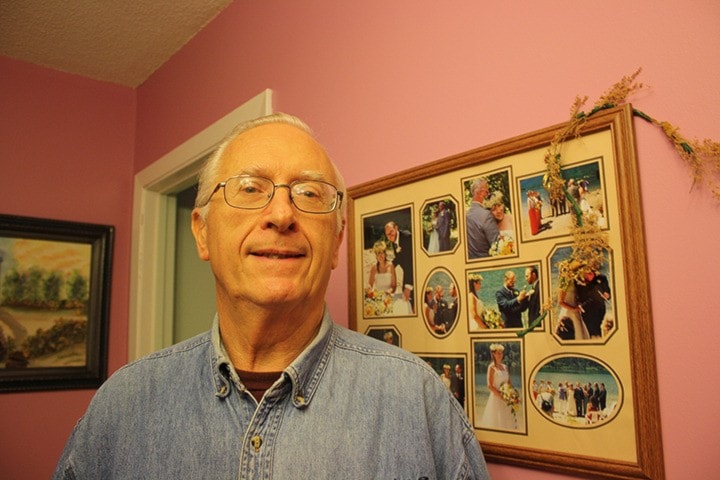Thirty-seventh in a series of pioneer profiles
Two milestones in local transportation history stand out among Joe Ringrose’s childhood memories. His family lived on the Nelson waterfront close to where the RCMP station is now, and as a two-year-old in 1946, he witnessed the launch of the new Kootenay Lake ferry.
“I didn’t know what it was, but I remember all these people — I couldn’t see anything — and a band playing,” he says. “Eventually it cleared enough and here was the Anscomb.”
Fast forward 11 years to the last run of the SS Moyie. Ringrose, who hawked the Vancouver Province, was trying to sell a souvenir edition when the old boat made its final stop in Nelson.
“I hustled papers for an hour and a half,” he recalls. “I was aggressive. ‘Paper, sir? Paper, sir?’ But I never sold a single, solitary paper. Nobody wanted one. I was so depressed.”
(As a consolation, the Province agent gave him a dollar.)
Ringrose normally had better luck: he’d start at Lakeside Park, site of the ferry landing before the orange bridge was built, and could sell 50 papers a day. He’d stash them at various spots between the park and Kokanee Avenue, and keep only one in hand and another hidden in his bag. Approaching a prospective customer, he’d ask: “Buy my last paper, sir?”
“I don’t know if it worked,” he says. “A lot of people would give you a dime. As a kid, I made good money. When an ice cream cone cost a nickel, if you sold 50 papers and made a buck and a half, you’d won the lottery.”
On a long weekend, with the ferry line-up back to Hume school, he could make a killing.
The park loomed large in the lives of Joe and brothers Bill and Bob. They were always at the lakeshore, often in an old row boat. One year the lake came up so high the whole park was flooded, and Joe remembers hanging onto the concession stand counter from the boat.
He also remembers old men playing checkers on the big outdoor board, using iron rods to move the pieces, and a large swing suspended from one of the huge cottonwood trees near the present greenhouse. Several kids could use it at once: the oldest would hold on to the chains, and the youngest would be in the middle.
“Everybody would get this thing going back and forth ... We’d spend hours on it. When I finally got old enough to stand on one of the chains, a big wind storm blew a lot of those trees down.”
Grandfather arrived in 1890s
The Ringrose name has been around Nelson almost from the start.
Joe’s grandfather, also Joseph Ringrose, apprenticed in England as an electrical telegraph worker before coming to Canada in 1882 and homesteading in Manitoba.
During the Riel Rebellion, his horses and wagons were conscripted, and afterward, he gave up farming and headed further west. In Nelson, he installed the first phones for the Kootenay Lake Telephone Co. and worked on the city’s first hydro-electric plant on Cottonwood Creek.
During a spell with the BC Electric Railway in Vancouver, he met Jane Crichton Orr. They married in 1897 and had six children, two of whom died in infancy.
Jane died in 1908, not long after giving birth, while tuberculosis claimed Joseph in 1914. The children went to live with an uncle in Claresholm, Alta. for about a year before returning to Nelson to be raised by their former housekeeper, Maggie Fraser.
Three of the four kids never married. Charlotte had a long nursing career that took her to Balfour, Victoria, New York, and Hawaii. During the Second World War, she set up a 100-bed hospital on Maui to treat wounded soldiers.
Jim, a fine athlete, was considered the founder of the Fairview Athletic Club. He built a gas station and store on Nelson Avenue, known for its ice cream cones. It was expropriated in the 1950s to build the orange bridge.
Alex ran a painting business and once had the contract to paint the smokestacks in Trail. Unafraid of heights, he also worked on some very tall bridges.
Joe Jr. worked for the CPR as a painter and later a bridge and building foreman. He married Ethel Lewis and they raised three boys at 703 Third Street.
Charlotte, Jim, and Alex all returned to live at the family home at 120 Chatham Street.
Last of the Nelson Ringroses
Joe Ringrose — the third — spent 20 years as a mechanic with Plaza Gulf, where the 7-Eleven is now. Later, he worked for the provincial government as a mechanic, building superintendent, fleet manager, and in skills training.
“I had a lot of different careers,” he says. “I’m glad I did. I became a mechanic because I didn’t like paperwork. I remember sitting at my desk one day writing a contract and thinking ‘What happened?’”
He helped organize the midsummer curling bonspiel, in which he played for 35 years without winning a prize — a testament, he says, to the calibre of competition. In his 50s, he also rekindled his love of stock car racing.
Now retired, Joe, 68, and his family are the last Ringroses in the Nelson area — his brothers live in Squamish and Edmonton. He and wife Karen have lived at Willow Point since they married in 1970 and have wintered the last few years in Arizona.
He’s traced his family tree back to the 1600s and has a large collection of photos and memorabilia detailing the Ringrose legacy.
Previous instalments in this series
